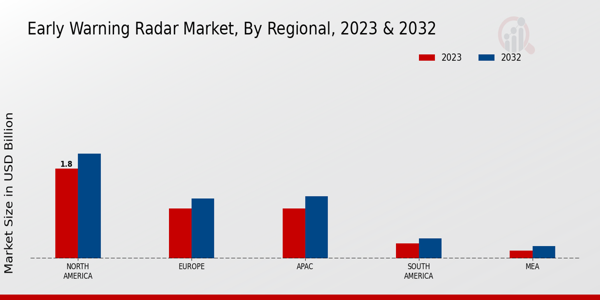Military Applications
The Global Early Warning Radar Market Industry is significantly influenced by military applications, where radar systems are essential for surveillance and reconnaissance. Modern military operations increasingly rely on advanced radar technologies to detect threats and monitor airspace. Countries are investing heavily in upgrading their radar systems to maintain strategic advantages. The integration of radar with other technologies, such as drones and satellite systems, enhances operational efficiency. This focus on military applications is expected to drive substantial growth in the market, as defense budgets continue to prioritize advanced radar capabilities.
Environmental Monitoring
The Global Early Warning Radar Market Industry is also benefiting from the growing emphasis on environmental monitoring. Radar systems are utilized to track changes in weather patterns, monitor climate change, and assess environmental hazards. This application is particularly relevant as global awareness of environmental issues increases. Organizations are leveraging radar technology to gather data that informs policy decisions and disaster response strategies. As the demand for reliable environmental monitoring solutions rises, the market is poised for growth, aligning with broader sustainability goals and initiatives.
Technological Advancements
The Global Early Warning Radar Market Industry is experiencing a surge in technological advancements, particularly in radar systems that enhance detection capabilities. Innovations such as phased array radar and synthetic aperture radar are becoming increasingly prevalent. These technologies allow for improved accuracy and range, which is crucial for early warning systems in various applications, including weather forecasting and military surveillance. As a result, the market is projected to reach 4.35 USD Billion in 2024, reflecting a growing demand for sophisticated radar solutions that can operate in diverse environments.
Government Initiatives and Funding
Government initiatives play a pivotal role in the Global Early Warning Radar Market Industry, as many countries are prioritizing investments in national security and disaster preparedness. Funding from governmental bodies is often allocated to enhance radar capabilities, ensuring that systems are up-to-date and effective. For example, various nations have launched programs aimed at improving their radar infrastructure, which not only bolsters defense mechanisms but also aids in environmental monitoring. This proactive approach is likely to sustain a compound annual growth rate of 2.25% from 2025 to 2035, reflecting the importance of government support in market expansion.
Increasing Demand for Disaster Management
The Global Early Warning Radar Market Industry is driven by an escalating need for effective disaster management solutions. Governments and organizations are investing in early warning systems to mitigate the impacts of natural disasters such as floods, hurricanes, and tsunamis. For instance, countries prone to such events are adopting advanced radar technologies to provide timely alerts to their populations. This trend is expected to contribute to the market's growth, with projections indicating an increase to 5.56 USD Billion by 2035. The emphasis on disaster preparedness is likely to sustain the demand for early warning radar systems.
























Leave a Comment